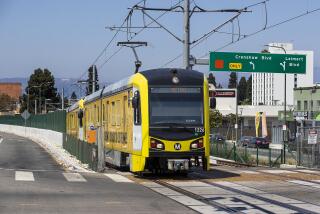OCTA’s Surveys on CenterLine May Not Tell the Whole Story
- Share via
The Orange County Transportation Authority has conducted several opinion polls that seem to bolster its contention that the public strongly supports the CenterLine light rail system. Taken on face value, several do just that. However, face value may not reveal the true nature of public opinion.
Several issues exist regarding any poll. First, did the format influence the answers? Second, did the respondents know what they were talking about? Third, were the answers truthful?
It is up to the pollster to address these issues and if not, then the burden is on the public and elected officials to question the veracity of the results. When evaluated, the OCTA polls are suspicious.
Several people have attacked the use of leading questions to provide answers favorable to light rail in an OCTA survey conducted this fall by Steinberg and Associates. The survey responses were also suspect.
For example, only 26% of those surveyed had ever heard of the CenterLine, yet 50% thought that the rail would not generate significant noise. One asks if they had not heard of the system, how could they know about the noise level?
While only 16% in the survey indicated that building a new light rail was most important compared to 60% favoring freeways and roads, the OCTA at a board meeting several weeks ago quoted from another question, which, after a rail-oriented preamble, showed 59% favored building the light rail.
In this same survey, 60% said they would use the rail system and 15% to 18% indicated they would use it often. There are over 10 million trips taken by everybody each day in Orange County for commuting, shopping and other things, according to the OCTA. Responses indicate that there would be between 800,000 and 1.7 million trips a day taken on the rail line if everybody who said they would use the system actually did.
If you set aside the survey results, the projections OCTA has made, which tend to be inflated, predict at most 70,000 trips a day on the rail line. Of course, with the latest proposal of a 12-mile line from Costa Mesa to Irvine, the daily ridership will be about 15,000, if you make the adjustment for the curtailed system.
In Los Angeles, with three established light rail lines and several times the population, the total daily count is about 100,000 per day. How do those surveyed result in such unrealistic anticipated use of between 800,000 and 1.7 million for Orange County?
The answer lies in the fact that the response the public gives to such questions is often more optimistic than realistic. While we cannot test this hypothesis on the yet-to-be-built rail line, other surveys provide good benchmarks for this assertion.
Every few years the Southern California Assn. of Governments conducts a survey titled “The State of the Commute.” Orange County commuters who do not have access to a carpool lane are asked whether HOV-lane availability would encourage them to carpool to work. Fifty percent answer in the affirmative. But in Orange County, 79% of commuters do have HOV availability and only 13% actually carpool.
Most of the car-poolers are car-pooling for reasons that have nothing to do with the existence of the HOV lane. It is estimated that only about 2% of the commuters carpool because the lanes are available; the rest do so for a variety of other reasons.
One can speculate on the reason for the difference between the survey response of 50% anticipating carpool use and the reality of 2% actually being influenced by the carpool lanes’ availability. One answer may be that the results of the poll reflect people’s desires rather than predict their future actions.
The main message is that poll answers often are not reliable predictors of behavior. Pollsters know this and have the obligation to point out questionable results. More important, the intended audience should be aware of these results and should then question the meaning of the entire poll. The OCTA board was elected to provide insight and guidance, and to make decisions in the public’s best interest. It was not elected to rubber stamp evidence to support a predefined position, and it should fairly and critically question all evidence.
The OCTA is now addressing which of several alternatives to promote, including the new 12-mile route, which eliminates the North County cities. The question they should answer is whether a light rail should be built at all, not which of alternate paths it should take. The authority should address how to achieve the most cost-effective and useful public transportation and highway systems for the county.
More to Read
Sign up for Essential California
The most important California stories and recommendations in your inbox every morning.
You may occasionally receive promotional content from the Los Angeles Times.













